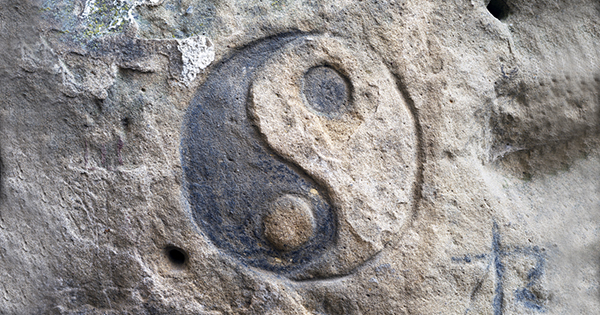In the practice of Taijiquan (太極拳), we strive to properly balance the yin (阴) and yang (阳) principles such that there is no excess and no deficiency, no protrusions and no depressions, no resisting but also no collapsing. Fangsong (放松 release or let go + loose = “relax”) and peng (掤 outward supportive structure, or “muscle tonus”) are terms/principles that Taijiquan uses to address these dualities.
There are two common ways that the term peng is used. One is the structural energy that fills out the shape of our body, and the other is the energy applied as one of the thirteen energies/techniques (十三式 shi san shi) of Taijiquan, and which is often translated as “warding off” or “rebounding” energy.
This article uses the general structural principle for peng; it is like the air that fills a properly inflated rubber ball and gives it the resilient structure allowing the peng application to bounce away incoming forces.
While there are numerous articles about fangsong, few tie this concept together with peng; but fangsong is the yin to peng’s yang. We strive to have both, and to train our bodies in a manner that they are complementary, not contradictory.
For examples of writings on fangsong (frequently shortened to just song), see the following:
http://www.egreenway.com/taichichuan/relax1.htm
It makes sense to emphasize fangsong first because most beginning practitioners start out being too stiff or rigid. Most intermediate and even advanced practitioners can still improve their fangsong. But this is also true for peng. Most practitioners can improve their structures such that the “nine pearl bends” (九曲珠 jiu qu zhu) are aligned with force/energy transmitted through stabile centers.
One way to view the nine pearl bends is to think of nine pearls on a string. If they are all touching and all of their centers align, then force that is applied to the first pearl can easily be transmitted all the way to the last pearl. But if the centers are not aligned, then the force will cause a bend to occur. The force would then “leak” out to the side.
In our bodies, if forces are transmitted through the centers of our joints (our “pearl bends”), then that force can be efficiently transmitted, without “leakage” to the sides which would require tensing muscles (or locking the structure) in order to hold the joints in place.
The better aligned our skeletal structure is, the less we need to use muscles to resist deformation of our structure. Holding the structure in alignment, for receiving or transmitting forces without “leakage”, allows for greater relaxation. Relaxation depends on good structure, and a good structure is one that aligns and, therefore, can be relaxed.
In the following video of a Newton’s Cradle toy, all of the balls’ centers align and allow force to be transmitted through them to the other balls. But at ~1:38-1:41 the balls’ centers are misaligned since they were wiggling too much when started, resulting in force “leaking” out the side and disrupting the transmission of force.
In Taijiquan we want an aligned and “full” structure (peng) rather than a collapsed or limp structure. We want a resilient structure that continuously balances yin and yang whether we are issuing or receiving forces.
Since we are structurally dynamic, unlike a pearl, our movements can result in the energy moving around our joints rather than through the centers, but this should still balance yin with yang in a manner similar to the rotation of a toy top where the spinning stabilizes the top. This motion is easy to illustrate by rotating the hips while keeping the center of the body (the spine) stable and centered. We can maintain “central equilibrium” (中定 zhongding) while rotating around parts of our body, including individual joints.
Another way one can look at this is to recognize that all joints have extensor and flexor muscles that move them. These complementary sets of muscles work on opposing sides of the joints and can therefore be used to stabilize the center of the affected joint. But rather than producing isometric tension that locks a joint in one rigid position, we can instead use these opposing muscles in a dynamic spiraling way that stabilizes the joint without locking it.

Leave a Reply